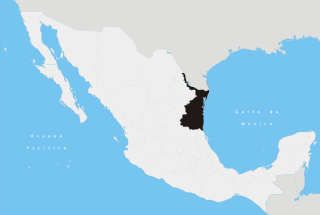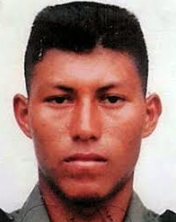
Osiel Cárdenas Guillén is a Mexican drug lord and the former leader of the Gulf Cartel and Los Zetas. Originally a mechanic in Matamoros, Tamaulipas, he entered the cartel by killing Juan García Abrego's friend and competitor Salvador Gómez, after the former's arrest in 1996. As confrontations with rival groups heated up, Osiel Cárdenas sought and recruited over 30 deserters from the Grupo Aeromóvil de Fuerzas Especiales to form the cartel's armed wing. Los Zetas served as the hired private mercenary army of the Gulf Cartel.

The Gulf Cartel is a criminal syndicate and drug trafficking organization in Mexico, and perhaps one of the oldest organized crime groups in the country. It is currently based in Matamoros, Tamaulipas, directly across the U.S. border from Brownsville, Texas.

Jorge Eduardo Costilla Sánchez is a former Mexican drug lord and top leader of the criminal drug trafficking organization known as the Gulf Cartel. He was among Mexico's most-wanted drug lords, until his arrest in 2012.

Antonio Ezequiel Cárdenas Guillén, commonly referred to by his alias Tony Tormenta, was a Mexican drug lord and co-leader of the Gulf Cartel, a drug trafficking organization based in Tamaulipas. He headed the criminal group along with Jorge Eduardo Costilla Sánchez. Antonio was considered by Mexican security forces as one of Mexico's most-wanted men.

Mario Alberto Cárdenas Guillén is a former leader of the Mexican criminal group called the Gulf Cartel. He is the brother of Osiel Cárdenas Guillén and Antonio Cárdenas Guillén.
Hugo Baldomero Medina Garza is a Mexican drug lord and leader of the Gulf Cartel. He is known as El Señor Padrino de los Tráilers for shipping large sums of Colombian narcotics in trucks through Mexico, to later smuggle them across the international border into the United States.
Homero Enrique Cárdenas Guillén, also known by his aliases El Majadero and El Orejón, was a Mexican suspected drug lord and alleged leader of the Gulf Cartel, a drug trafficking organization. He is the brother of the former Gulf Cartel leaders Antonio, Mario, and Osiel Cárdenas Guillen. During the late 1990s, Homero worked for the Gulf Cartel under the tutelage of his brothers. However, after several years of government crackdowns, the Gulf Cartel suffered severe drawbacks, including the death and arrests of Homero's brothers and allies. In August 2013, Homero became the de facto leader of the Gulf Cartel following the arrest of Mario Ramírez Treviño. However, he reportedly died of a heart attack on 28 March 2014.

On 9 November 1999, two agents from the United States Drug Enforcement Administration (DEA) and Federal Bureau of Investigation (FBI) were threatened at gunpoint and nearly killed in Matamoros, Tamaulipas, Mexico, by gunmen of the Gulf Cartel, a criminal group based in the area. The two agents traveled to Matamoros with an informant to gather intelligence on the operations of the Gulf Cartel. As they cruised through one of the properties owned by the criminal group, they noticed several vehicles following them. The agents were forced to a stop and were corralled by a convoy of eight vehicles, from which fifteen gunmen emerged and surrounded the agents' car. Some of them wore uniforms of the local police. Among the gunmen was the former kingpin Osiel Cárdenas Guillén, who recognized the informant and ordered the three of them to get out of their vehicle.

Adán Javier Medrano Rodríguez, also known as El Licenciado, was a Mexican convicted drug lord and former high-ranking member of the Gulf Cartel, a criminal group based in Tamaulipas, Mexico. He joined the cartel during the 1990s, and was a trusted enforcer of former kingpin Osiel Cárdenas Guillén. His roles in the cartel were managing drug shipments from Guatemala to Mexico, supervising murders ordered by Cárdenas, and coordinating cash transfers from the U.S. to Mexico.

Gilberto García Mena, also known as El June, is a Mexican convicted drug lord and former high-ranking member of the Gulf Cartel, a criminal group based in Tamaulipas, Mexico. He began his criminal career as a small-time marijuana smuggler in his teens, and later joined the Gulf Cartel under kingpin Juan García Ábrego. García Mena was arrested by U.S. authorities in Texas while possessing marijuana in 1984, but was released without a conviction. He returned to Mexico, and established a center of operations in Nuevo León. García Mena was arrested on drug-trafficking charges in 1989, but authorities were again unable to convict him. Released in 1990, he rejoined the Gulf Cartel.

Juan Carlos de la Cruz Reyna is a Mexican convicted criminal and former high-ranking member of the Gulf Cartel, a criminal group based in Tamaulipas, Mexico. He was also a senior member in Los Zetas, the Gulf Cartel's former paramilitary group. In the 1990s, de la Cruz Reyna was an officer in the Tamaulipas State Police while working as a hitman for the Gulf Cartel. After he left the agency in 1999, he became a bodyguard for former Gulf Cartel kingpin Osiel Cárdenas Guillén, and was eventually promoted to regional leader of the cartel in Tampico. He reportedly had policemen on his payroll, and managed international drug trafficking shipments from Central and South America.

Víctor Manuel Vázquez Mireles is a Mexican drug lord and high-ranking member of the Gulf Cartel, a criminal group based in Tamaulipas, Mexico. Vázquez Mireles joined the cartel during the 1990s and was a trusted enforcer of former kingpin Osiel Cárdenas Guillén. He started his career in the cartel as one of his bodyguards and was eventually placed in charge of operations in Tamaulipas and Veracruz. He was reportedly responsible for supervising the purchase of drugs intended to be smuggled into the U.S. for distribution and for arranging the assistance of corrupt law enforcement officials in the cartel's operations.

Edelio López Falcón, commonly referred to as El Yeyo, was a Mexican suspected drug lord and former high-ranking member of the Gulf Cartel, a criminal group based in Tamaulipas, Mexico. Prior to his involvement in drug trafficking, López Falcón owned a flower business in Miguel Alemán. He was part of the cartel during the 1990s and was a trusted enforcer of the former kingpin Gilberto García Mena. López Falcón's role in the cartel was managing drug shipments from Tamaulipas to the United States. Security forces believed López Falcón was not a violent crime boss; he preferred to indulge in his personal interests, which included promoting music and entertainment, managing his restaurant chains, and running his horse-breeding business. After joining the cartel, he continued to pose as a legitimate businessman to keep a low profile.
Rolando López Salinas, also known as El Rolis, was a Mexican suspected drug lord and former high-ranking member of the Gulf Cartel, a criminal group based in Tamaulipas, Mexico. López Salinas started his criminal career as the right-hand man of his cousin Edelio López Falcón and was in charge of his security services, and later became involved in drug trafficking operations. During his criminal career, López Salinas survived two assassination attempts—one in 1999 and another in 2000—which were reportedly triggered by his differences with Gilberto García Mena, a former cartel boss. After López Falcón came into conflict with the cartel's leadership, both he and López Salinas broke ties with the cartel and forged alliances with rival criminal groups.

Zeferino Peña Cuéllar, also known as Don Zefe, is a Mexican suspected drug lord and high-ranking member of the Gulf Cartel, a criminal group based in Tamaulipas, Mexico. He was part of the cartel during the 1990s, and was a trusted enforcer of former kingpins Gilberto García Mena and Osiel Cárdenas Guillén. From 1999 to 2001, he served as the municipal police chief of Miguel Alemán. Peña Cuéllar reportedly relied on corrupt Mexican military officials to run drug trafficking activities in Tamaulipas. This group of military officers would later become the foundation for the creation of Los Zetas, the Gulf Cartel's former paramilitary group originally made up of ex-soldiers. In the cartel, he headed organized crime operations in the municipalities of Gustavo Díaz Ordaz, Camargo, Miguel Alemán, Mier, and Guerrero.

Raúl Hernández Barrón, also known by his alias Flanders 1, was a Mexican suspected drug lord and high-ranking member of Los Zetas, a criminal group based in Tamaulipas, Mexico. Hernández Barrón served in the Mexican Army from 1993 to 1999 as an infantry soldier. He then left and joined the Gulf Cartel under the kingpin Osiel Cárdenas Guillén, and became part of the first members of their newly formed paramilitary wing, Los Zetas. Like Hernández Barrón, most of the first members of Los Zetas were ex-military. Los Zetas was responsible for providing security services to Cárdenas Guillén and carrying out executions on the cartel's behalf. Hernández Barrón was also responsible for coordinating drug trafficking activities in Veracruz.

Raúl Alberto Trejo Benavides was a Mexican suspected drug lord and high-ranking member of Los Zetas, a criminal group based in Tamaulipas, Mexico. Trejo Benavides served in the Mexican Army from 1991 to 1999, and was a member of the Grupo Aeromóvil de Fuerzas Especiales (GAFE), the army's special forces. He joined the Gulf Cartel under kingpin Osiel Cárdenas Guillén after leaving the army, becoming one of the first members of its newly formed paramilitary wing, Los Zetas. Like Trejo Benavides, most of the first members of Los Zetas were ex-military. Los Zetas was responsible for providing security services to Cárdenas Guillén and carrying out executions on the cartel's behalf.

María Antonieta Rodríguez Mata is a Mexican former police officer and convicted drug lord. She worked as a Tamaulipas State Police officer from 1992 to 1996. During her tenure in the police, she was subject to several investigations by the National Human Rights Commission for alleged human rights violations. In the late 1990s, she became involved with the Gulf Cartel, a criminal group based in Tamaulipas, Mexico, after being hired to work under the kingpin Osiel Cárdenas Guillén. She was responsible for coordinating drug trafficking shipments from Colombia, Guatemala, and Mexico to the U.S. The drugs were often guarded by corrupt policemen and smuggled overland through Reynosa and McAllen, Texas. Her role in organized crime is unusual since she held a leadership role in the male-dominated Mexican drug trafficking industry.

Luis Alberto Guerrero Reyes was a Mexican suspected drug lord and high-ranking member of Los Zetas, a criminal group based in Tamaulipas, Mexico. He joined the Mexican Army in 1987, specializing in explosives, martial arts and grenade launchers. In 1999, he deserted the military and joined the Gulf Cartel under kingpin Osiel Cárdenas Guillén, becoming one of the first members of its newly formed paramilitary wing, Los Zetas. Like Guerrero Reyes, most of the first members of Los Zetas were ex-military. Los Zetas was responsible for providing security services to Cárdenas Guillén and carrying out executions on the cartel's behalf.

Omar Lorméndez Pitalúa is a Mexican suspected drug lord and high-ranking member of Los Zetas, a criminal group based in Tamaulipas, Mexico. He joined the Mexican Army in 1991 and deserted in 1999. He then joined the Gulf Cartel under kingpin Osiel Cárdenas Guillén, becoming one of the first members of its newly formed paramilitary wing, Los Zetas. Like Lorméndez Pitalúa, most of the original members of Los Zetas were ex-military. Los Zetas was responsible for providing security services to Cárdenas Guillén and carrying out executions on the cartel's behalf. In 2001, Lorméndez Pitalúa worked on assignments for Los Zetas and was responsible for ensuring that smugglers paid taxes to the Gulf Cartel and operated under their supervision in Matamoros.











